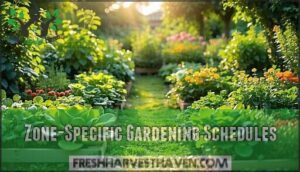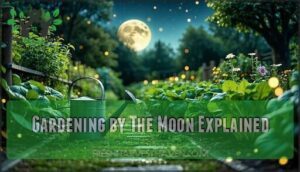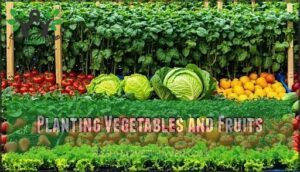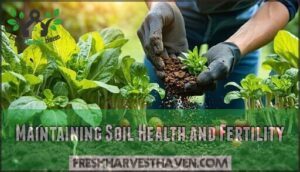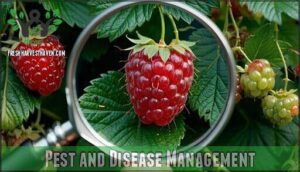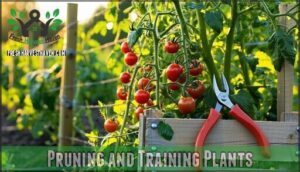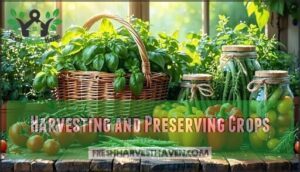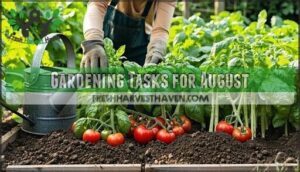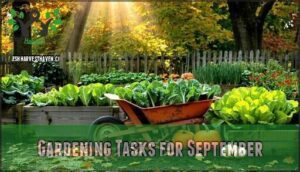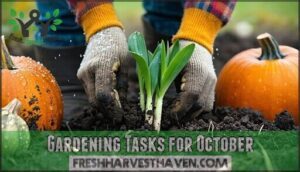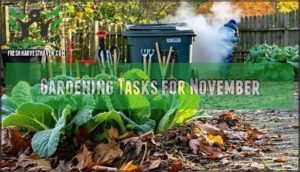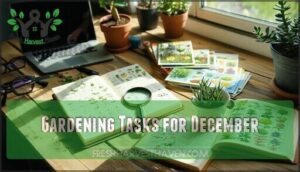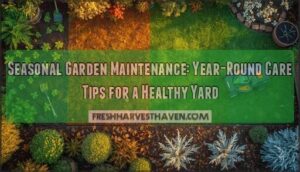This site is supported by our readers. We may earn a commission, at no cost to you, if you purchase through links.
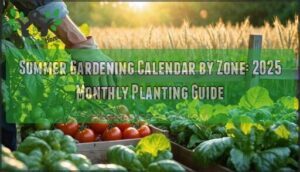
You’ll plant heat-loving crops like tomatoes and peppers in June if you’re in cooler zones, but Zone 9 gardeners might already be thinking fall plantings.
Each zone has specific windows for succession planting, pest management, and harvest timing that align with your local climate patterns.
For instance, Zone 5 gardeners typically start fall crops in July, while Zone 8 can wait until August.
The key is matching your planting schedule to your zone’s unique frost dates and temperature swings, ensuring you’re working with nature rather than fighting it.
Your monthly tasks will reveal surprising strategies that most gardeners overlook, using complete concepts to improve your gardening skills.
Table Of Contents
- Key Takeaways
- Summer Gardening Calendar Overview
- Zone-Specific Gardening Schedules
- Gardening by The Moon Explained
- Gardening Tasks for June
- Gardening Tasks for July
- Gardening Tasks for August
- Gardening Tasks for September
- Gardening Tasks for October
- Gardening Tasks for November
- Gardening Tasks for December
- Frequently Asked Questions (FAQs)
- What is a planting calendar?
- How do I know if I need a gardening calendar?
- Do you need a vegetable planting calendar?
- Can you plant vegetables in July?
- What can I plant in a summer garden?
- What is a succession planting calendar?
- What is a homestead and chill garden planting calendar?
- When should I plant a garden in zone 7-8?
- When should I start planting my summer garden?
- What to plant when in Illinois?
- Conclusion
Key Takeaways
- Time your plantings to your specific hardiness zone – You’ll plant heat-loving crops like tomatoes in June for cooler zones, but Zone 9 gardeners should focus on fall plantings during summer months.
- Use succession planting every 2-3 weeks – You’ll guarantee continuous harvests by staggering crops like lettuce and beans throughout the growing season rather than getting overwhelmed with one large harvest.
- Match your frost dates with planting windows – You’ll maximize success by aligning your planting schedule with your zone’s unique frost dates and temperature patterns instead of following generic calendar dates.
- Focus on zone-specific monthly tasks – You’ll tackle heat management and soil health in summer, transition to cool-season crops in fall, and use winter months for planning and tool maintenance based on your zone’s growing season length.
Summer Gardening Calendar Overview
Summer gardening requires careful timing and zone awareness to achieve the best results.
Your growing season depends on your hardiness zone, frost dates, and local climate conditions that determine when to plant, water, and harvest your crops, which is crucial for successful gardening.
Importance of Seasonal Gardening
Instead of fighting nature’s rhythms, seasonal gardening harnesses powerful forces like Climate Adaptation and Pest Cycles to maximize your harvest.
Following a summer garden calendar customized to your zonespecific planting needs transforms guesswork into guaranteed success, building Soil Health and encouraging Biodiversity naturally.
Smart seasonal gardening means:
- Planting crops when they naturally thrive in your zone
- Establishing effective Crop Rotation patterns that prevent disease
- Working with natural planting season cycles for peak flavor harvests
Factors Affecting Gardening Success
Your garden’s success hinges on soil quality, sunlight exposure, and smart watering practices.
Test soil pH and add compost for healthy roots.
Microclimate effects from buildings or trees change growing conditions within your yard.
Pest control starts with weekly monitoring.
Local gardening conditions vary by zone-specific planting requirements.
Your summer garden calendar should match these factors affecting gardening success.
Map sun patterns, establish deep watering schedules, and choose plants suited to your gardening by zone needs.
Understanding these basics transforms struggling plots into thriving harvests.
Zone-Specific Gardening Schedules
Your specific hardiness zone determines when you’ll plant, what you’ll grow, and how you’ll manage your garden throughout the summer months.
Each zone has distinct frost dates, growing seasons, and climate challenges that shape your gardening calendar from June through August, based on your zone’s unique characteristics and climate challenges.
Zone 7 Gardening Tasks and Tips
Zone 7 gardeners enjoy a sweet spot with 210 frost-free days from mid-April to mid-November. This extended season allows multiple plantings and ambitious summer gardening calendar by zone projects that shorter seasons can’t support.
Heat management becomes your summer priority. Water deeply in early morning to help plants withstand afternoon temperatures. Mulch heavily around plants to retain moisture and regulate soil temperature. Position tall crops to shade heat-sensitive vegetables during peak summer hours.
Pest control requires vigilance during these long, warm months. Scout weekly for insects and diseases that thrive in Zone 7’s extended heat. Act quickly when problems appear.
Soil health depends on regular compost additions. The longer season depletes nutrients faster, so feed your garden consistently. Succession planting works perfectly here – plant lettuce and beans every two weeks for continuous harvests. Knowing the approximate first frost date is essential for planning late-season plantings.
Your zone 7 gardening tasks and tips should focus on maximizing this generous growing window through smart gardening zones planning and consistent planting calendar management.
Zone 8 Gardening Tasks and Tips
With 240 frost-free days stretching from March through November, you’ll master zone 8’s extended growing season through smart timing and heat management. Heat-loving crops like tomatoes and peppers thrive here, while succession planting guarantees continuous harvests throughout your summer planting guide period.
The long growing season allows for planting a diverse range of plants.
Your zone 8 gardening tasks and tips center on managing intense summer heat and maintaining soil moisture during scorching July-September weather. Strategic watering techniques and pest management become vital as insects flourish in extended warmth.
- Test soil pH monthly and add organic matter for healthy plant health
- Install drip irrigation systems to conserve water during peak summer heat
- Practice succession planting every 2-3 weeks for continuous vegetable harvests
- Apply deep mulch around plants to retain soil moisture and regulate temperature
Gardening Tasks for Other Zones
While gardeners in Zones 7 and 8 enjoy moderate conditions, other zones face distinct challenges that require targeted Zone 5 strategies and Zone 6 planting approaches.
Zone 5 strategies focus on timing since your last frost arrives in mid-May. Start warm-season crops indoors 6-8 weeks early, then transplant after soil warms to 60°F. Zone 6 planting offers more flexibility with an April last frost, allowing direct seeding of cool-season crops by mid-March.
Zone 11 challenges center on year-round pest pressure and extreme heat. Your summer planting guide should emphasize heat-resistant varieties and integrated pest management. Zone 12 crops thrive in constant warmth but need excellent drainage during heavy summer rains.
Zone 13 gardening requires shade structures and disease prevention due to intense humidity. Your regional garden calendar should include multiple planting windows since crops can grow continuously.
Each local hardiness zone demands specific zone-specific gardening schedules. Your planting calendar must account for your zone’s unique climate patterns.
Gardening by The Moon Explained
You’ve probably heard gardeners swear by planting with the moon’s phases, and there’s actually some science behind this ancient practice.
The moon’s gravitational pull affects plant growth cycles, with different phases being ideal for specific gardening tasks like planting, pruning, and harvesting.
How The Moon’s Phases Affect Plant Growth
Celestial forces shape your garden’s growth patterns through lunar cycles.
The moon’s gravitational pull affects moisture movement in plants, with waxing phases drawing water upward for vigorous leaf growth and waning phases strengthening root systems.
Biodynamic gardening principles recognize these natural rhythms:
- New moon phases trigger enhanced seed germination rates
- Waxing crescents boost leafy green growth and stem development
- Full moon cycles optimize transplanting success through peak moisture conditions
- Waning phases strengthen root development and underground growth
- Lunar planting schedules maximize harvest potential through natural timing
Moon cycles influence plant metabolism differently than myth vs. science debates suggest.
Tides influence extends beyond oceans to affect cellular water movement in plants, making planting times vital for garden success.
Best Days for Planting and Gardening
Optimal Timing combines lunar cycles with weather patterns to maximize garden success.
Lunar planting enthusiasts track moon phases for astrological influences that affect soil moisture and plant growth. Your biodynamic calendar identifies when gravitational forces support stronger root development and better germination rates.
Optimal planting times align these celestial windows with your zone-specific gardening schedules. Cross-reference your planting calendar with moon phases to find the sweet spot for seeding.
Planting dates by zone become even more effective when timed with favorable lunar periods. Gardening by the moon explained simply means working with natural rhythms rather than against them.
Farmers’ Almanac Planting Calendar
For over 200 years, the farmers almanac planting calendar has guided gardeners through Almanac Accuracy rooted in Historical Context. This trusted Planting Guide combines astronomical data with agricultural wisdom, creating your personalized zone planting calendar based on USDA Plant Hardiness Zone data and Lunar Gardening principles.
The farmers almanac planting calendar provides Regional Variations across garden zones, timing your planting dates by zone with both moon phases and local frost dates.
Here’s how to use this time-tested system:
- Find your specific zone in the planting calendar
- Match lunar cycles with recommended planting windows
- Adjust for local microclimates and soil conditions
- Track both frost dates and moon phases for ideal timing
- Plan succession plantings using the monthly guides
This proven approach transforms gardening guesswork into strategic planning.
Gardening Tasks for June
June kicks off the peak summer growing season when your garden hits its stride.
June transforms your garden into a thriving powerhouse of growth and abundance.
You’ll focus on planting heat-loving** crops, maintaining soil health, and staying ahead of pests before the hottest weather arrives.
Planting Vegetables and Fruits
Nearly every June, your summer garden schedule kicks into high gear. This is the sweet spot for planting Summer Vegetables and Regional Fruits, thanks to warm soil and longer days.
Use your vegetable planting guide and check planting dates by zone—timing is everything. Tomatoes and peppers thrive when planted now, while quick crops like bush beans and lettuce love Succession Planting every two weeks for steady harvests.
Don’t forget to support tomatoes with sturdy stakes or cages for the best results. Strawberries and other small Fruit Varieties set strong roots when planted in early summer. Consider purchasing summer vegetable plants to expand your garden’s diversity.
Pay close attention to zone-specific gardening schedules to avoid frost surprises and maximize yields. Try different Planting Techniques for better results, and use a summer vegetable planting chart for your area to ensure the best outcomes.
- Try different Planting Techniques for better results
- Use a summer vegetable planting chart for your area
- Plant bush beans and lettuce in waves for more harvests
- Choose Fruit Varieties that fit your local climate and soil
Maintaining Soil Health and Fertility
June brings peak growing season, making soil health your garden’s foundation.
Start with soil testing to identify nutrient gaps. Apply compost generously—two inches around plants feeds beneficial microbes.
Natural fertilizers like fish emulsion boost growth without chemicals. Mulching benefits include cooler soil and better soil moisture retention.
Add organic matter weekly through kitchen scraps or grass clippings. Monitor moisture levels daily during hot spells.
Healthy soil equals thriving plants all summer long.
Pest and Disease Management
Summer heat brings bugs and blights that can devastate your garden. Check plants twice weekly for early warning signs and take swift action. Integrated pest management combines prevention, monitoring, and targeted control to protect your harvest naturally.
Watch for these trouble indicators:
- Holes or ragged leaf edges from chewing insects
- Sticky honeydew residue from aphids or scale
- Yellow or brown patches indicating fungal issues
- Curled leaves despite proper watering
- Visible bugs or egg clusters on leaf undersides
Start with organic pesticides like neem oil and insecticidal soaps. Encourage beneficial insects through companion planting with nectar-rich flowers. Practice crop rotation and improve soil health to strengthen plant resistance. This disease prevention approach stops problems before they spread, ensuring a healthy and thriving garden through natural means.
Gardening Tasks for July
July brings peak summer heat and your garden’s most productive period.
You’ll need to master efficient watering techniques, stay on top of pruning to keep plants healthy, and harvest crops at their prime for maximum flavor and nutrition.
Watering and Irrigation Techniques
July’s scorching heat demands strategic watering techniques to keep your garden thriving.
Implement a watering schedule of three deep sessions weekly, delivering one inch total through efficient watering methods.
Drip irrigation systems reduce water loss by 60% compared to overhead sprinklers while maintaining ideal soil moisture levels.
Consider complete drip irrigation for optimal water usage.
Practice water conservation by watering during early morning hours when evaporation losses are minimal.
Check soil moisture two inches deep before irrigating – dry soil signals it’s time for your irrigation systems to work their magic in water-efficient gardening.
Pruning and Training Plants
After consistent watering in July, your plants need proper pruning techniques and training methods to maximize their potential.
This month’s warm weather creates ideal conditions for shaping growth and establishing plant support systems.
Three game-changing pruning techniques for July:
- Remove suckers and water sprouts – These energy thieves steal nutrients from fruit production and create dense, unproductive growth
- Pinch growing tips – Encourage bushier growth in herbs and vegetables by removing the top inch of new shoots
- Thin overcrowded branches – Improve air circulation and light penetration by removing weak or crossing branches
Tool selection matters for successful pruning. Use sharp, clean bypass pruners for stems under ¾ inch and loppers for thicker branches.
Your summer gardening calendar by zone determines the best timing for these tasks.
Training methods like staking tomatoes and trellising cucumbers prevent disease and improve yields.
Zone-specific gardening schedules help you time these activities perfectly, ensuring your microclimate management supports healthy plant varieties throughout the growing season.
Harvesting and Preserving Crops
Peak harvest time arrives when your crops show their maturity signs.
You’ll capture maximum flavor and nutritional value by harvesting during cool morning hours when natural sugars concentrate.
Check seed packets for specific harvest timing indicators to guarantee harvest success.
| Crop | Peak Harvest Signs | Storage Method |
|---|---|---|
| Tomatoes | Fully colored, slight give | Freeze whole or make sauce |
| Beans | Pods snap cleanly | Blanch then freeze |
| Herbs | Before flower buds open | Dry or freeze in oil |
| Peppers | Firm, glossy skin | Dehydrate or pickle |
Proper preservation methods extend shelf-life naturally.
Blanching stops enzyme activity before freezing, preserving color and nutrients.
Don’t let abundance overwhelm you—develop storage techniques that match your harvest volume.
Quick pickling, dehydrating, and freezing are your best friends for reducing waste.
Fruit harvesting follows similar principles: pick at peak ripeness for maximum preservation results.
Gardening Tasks for August
August brings peak summer heat and the perfect time to start planning your fall garden.
August transforms your garden into a bustling production center – time to harvest, prepare, and plan for autumn’s arrival.
You’ll need to tackle three key tasks: preparing beds for cool-season crops, managing persistent pests, and giving your plants the nutrients they need to finish strong.
Preparing for Fall Gardening
August brings a turning point for your garden’s autumn success. While summer crops reach their peak, it’s time to shift gears and prepare for fall’s bounty.
Soil preparation becomes your top priority as depleted beds need fresh compost and amendments. Start preparing for fall gardening by clearing spent plants and testing soil pH.
Fall vegetables like kale and spinach need nutrient-rich soil to establish strong roots before cooler weather arrives.
- Clear summer debris and add 2-3 inches of compost to garden beds
- Test soil pH and adjust with lime or sulfur for ideal fall vegetables
- Plan winter cover crops like crimson clover or winter rye for unused beds
- Organize tool storage areas and sharpen pruning shears for efficient work
- Set up frost protection supplies including row covers and cold frames
This groundwork guarantees your planting coolseason crops goes smoothly when September arrives.
Managing Summer Pests and Diseases
How do you spot trouble before it becomes a crisis?
Daily garden walks reveal early signs of pests like aphids, which can reduce yields by 30%.
Disease prevention starts with proper spacing and morning watering to minimize leaf wetness.
Organic controls like neem oil and beneficial insects provide effective pest management.
Ladybugs can reduce aphid populations by 90%, making them essential allies in your summer garden’s defense system.
Fertilizing and Mulching
Your plants demand proper nutrition and protection when summer heat intensifies. After managing pests and diseases, you’ll need to focus on feeding and protecting your garden.
Test soil first to identify nutrient deficiencies before applying any fertilizers. Your USDA Plant Hardiness Zone determines timing for ideal results. Smart gardeners know mulch types matter – straw keeps vegetables cool while wood chips work better for perennials.
Here’s your August fertilizing and mulching checklist:
- Test soil pH and nutrient levels using a simple soil test kit
- Apply slow-release organic fertilizers based on test results
- Add 2-3 inches of appropriate mulch around plants
- Water deeply after fertilizing to activate nutrients
- Consider compost application for long-term soil health benefits
Proper fertilizing and mulching practices maintain soil health while reducing watering frequency. Natural fertilizers release nutrients gradually, preventing plant burn during hot weather. This approach supports sustainable gardening while maximizing your harvest potential.
Gardening Tasks for September
September marks the shift from summer’s intense heat to autumn’s cooler temperatures, making it the perfect time to shift your gardening focus.
You’ll want to plant cool-season crops that thrive in the milder weather ahead while preparing your garden for the winter months.
Planting Cool-Season Crops
September’s cooling temperatures signal the perfect time for your garden’s second act. Cool-season crops thrive in this zone-specific gardening window, transforming your summer garden maintenance routine.
Early planting now guarantees robust fall harvests before winter arrives. These hardy vegetables actually prefer the shift from scorching days to crisp nights, developing superior frost tolerance naturally.
Your planting calendar strategy includes:
- Leafy greens like spinach, kale, and lettuce handle light frosts while delivering sweeter flavors as temperatures drop.
- Root vegetables including carrots, radishes, and turnips develop better taste when maturing in cooling weather conditions.
- Brassicas such as broccoli, cabbage, and cauliflower need this timing for proper head formation before winter sets in.
Monitor soil temperature closely – it should remain between 45-75°F for ideal germination. Succession planting every two weeks extends your harvest window substantially.
Dividing and Transplanting Perennials
After your cool-season crops find their footing, it’s time to tackle dividing and transplanting perennials while conditions remain ideal. September’s cooler temperatures create perfect conditions for Perennial Division Timing, reducing Transplanting Shock Reduction risks that summer heat brings.
Divide Perennials, Transplant Seedlings, Prepare Soil, and Water Well are essential steps in the process.
Dividing Mature Plants like hostas and daylilies works best now when Root Pruning Benefits help establish stronger systems. Sharp tools make clean cuts that heal quickly.
Post-Transplant Care includes deep watering and compost-enriched soil preparation. To further enrich the soil, consider adding aged manure to empty beds.
Your zonespecific gardening timeline guarantees these perennials settle before winter arrives, supporting ongoing summer garden maintenance goals.
Preparing for Winter Gardening
Your perennial division work sets the stage for successful winterizing garden preparations. As temperatures drop and frost dates approach, smart preparation now guarantees your garden thrives through winter months.
Begin soil preparation for cold-resistant crops like carrots, kale, and spinach. These hardy vegetables love cooler weather when you’ve enriched their growing medium with compost and organic matter. Winter crops need well-draining soil that won’t freeze solid.
Set up frost protection systems before you need them. Row covers, cold frames, and hoop tunnels create microclimates that extend your growing season. This preparation saves scrambling when unexpected cold snaps arrive.
Your winterizing checklist includes:
- Install frost protection structures around vulnerable plants
- Clean and organize tools for proper tool storage in dry locations
- Apply thick mulch layers to insulate root systems and suppress weeds
Don’t overlook fall planting dates for garlic, onions, and cover crops. These crops need time to establish before winter arrives. Start planning spring garden layouts now while this season’s successes and failures remain fresh in your memory.
Gardening Tasks for October
October brings cooler weather and the perfect time to plant spring-blooming bulbs before the ground freezes.
You’ll also want to add compost to garden beds and set up frost protection for tender plants that need to survive the coming winter.
Planting Bulbs and Garlic
October marks the perfect time to plant bulbs and garlic for next year’s garden rewards. This fall planting window guarantees proper root development before winter dormancy sets in.
Bulb depth follows a simple rule: plant at three times the bulb’s height. A 2-inch tulip bulb needs 6 inches deep, while smaller crocus bulbs go 3-4 inches down. Garlic varieties require different approaches—hardneck types for cold zones, softneck for warmer areas.
| Planting Item | Depth | Spacing | Timing |
|---|---|---|---|
| Spring bulbs | 3x height | 2-4 inches | Mid-October |
| Garlic | 2 inches | 4-6 inches | Late October |
Your planting calendar depends on zone—colder regions start earlier, while fall planting dates extend into November for warmer zones. Proper pest protection includes wire mesh over beds to deter rodents.
Well-prepared soil with good drainage prevents rot. These October efforts deliver spectacular spring blooms and fresh garlic harvests, making this planting bulbs and garlic season essential for garden success.
Applying Compost and Manure
Your garden’s soil craves nourishment after a busy growing season. Now’s the perfect time to boost soil health through strategic compost application and manure additions.
Compost benefits shine brightest in fall when cooler temperatures support nutrient cycling. Your gardening calendar zone determines exact timing, but most regions can start this soil enrichment process now. Well-aged materials break down slowly, feeding beneficial microorganisms through winter.
Manure types vary in strength and application methods. Fresh manure burns plants, so stick with aged varieties. Cow manure improves clay soils, while chicken manure adds quick nitrogen. Horse manure works well for sandy ground.
Follow these application methods for maximum soil improvement:
- Spread 2-3 inches of aged compost across empty beds
- Mix well-aged manure into heavy clay soils for better drainage
- Layer materials directly on existing mulch
- Water lightly after applying to activate decomposition
This maintaining soil health and fertility strategy sets up next year’s garden success.
Protecting Plants From Frost
When frost threatens your plants, swift action saves your harvest. Check frost dates in your area and prepare frost protection methods before temperatures drop below 32°F.
Understanding the nuances of frost versus freeze damage can help you tailor your approach.
Frost Protection Methods you can use include:
- Row covers – lightweight fabric that traps warm air while allowing light through
- Cold frames – wooden boxes with glass or plastic tops for cold frame construction
- Mulch insulation – thick organic layer around plant bases to retain soil heat
- Plant protection fabrics – specialized materials designed for overwintering strategies
- Water jugs – filled containers that release stored heat overnight
Monitor hardiness zone limits for your area. Frost protection works best when you understand your local climate patterns and act before damage occurs.
Gardening Tasks for November
November marks the final stretch of the growing season for most gardeners, making it the perfect time to wrap up your garden preparations for winter.
You’ll want to focus on planting hardy winter crops, protecting your trees and shrubs from harsh weather.
Getting your garden tools ready for storage is also crucial to ensure they remain in good condition until the next growing season.
Planting Winter Crops
Cool November air brings perfect timing for winter crop selection in your garden zones.
Plant cold hardy varieties like kale, Brussels sprouts, and winter lettuce that handle frost with ease.
Focus on soil preparation winter by mixing compost for drainage and nutrients.
Your planting calendar guides timing based on your USDA Plant Hardiness Zone.
Crop Planting Zone Frost Protection Methods
These frost protection methods guarantee successful fall planting while extending winter harvest through cold months ahead.
Pruning and Protecting Trees and Shrubs
November’s dormant season creates the perfect opportunity for essential tree and shrub maintenance. Winter protection and strategic pruning now will reward you with healthier plants come spring.
Start by removing dead, diseased, or crossing branches using clean, sharp tools. This prevents disease spread and improves overall plant structure. Focus on fruit trees and berry bushes, as dormant pruning reduces stress by 25% compared to growing season cuts. Shrub shaping during dormancy also stimulates better spring growth.
Apply these winter protection strategies:
- Mulch application: Spread 3-4 inches around tree bases to insulate roots and reduce soil temperature fluctuations
- Burlap barriers: Wrap vulnerable evergreens and woody ornamentals in windy locations to prevent desiccation
- Dormant oil treatment: Spray fruit trees to control overwintering scale insects and mites effectively
- Structural cleanup: Remove water sprouts and suckers to maintain proper tree form and prevent pest habitats
To further insulate roots, consider applying four inches of mulch after the ground freezes. These pruning techniques and disease prevention measures guarantee your landscape survives winter’s challenges while setting the stage for vigorous spring growth.
Preparing Garden Tools for Winter
Your well-maintained tools are your garden’s best friends come spring.
Clean each tool thoroughly with a wire brush, removing soil and debris that harbors disease. Oiling metal surfaces prevents rust during winter storage.
Sharpening blades now saves time later. Proper storage solutions like hanging tools or using toolboxes keeps everything organized.
For ideal care, consider specialized tool cleaning options. Rust prevention through simple tool maintenance makes preparing garden tools for winter worthwhile.
Gardening Tasks for December
December wraps up your gardening year with planning and reflection tasks that set you up for success next season.
You’ll focus on reviewing what worked well this year, maintaining any indoor plants or seedlings, and creating detailed plans for your 2026 garden layout and crop rotation.
Planning for Next Year’s Garden
December’s quiet season provides the perfect foundation for creating your most successful garden yet.
Smart gardeners use this downtime to craft a winning planting calendar for 2025 that maximizes every square foot of growing space.
Here’s your strategic garden planning roadmap:
- Review this year’s garden notes to identify which varieties thrived in your USDA Plant Hardiness Zone and which crops disappointed
- Create detailed Garden Mapping layouts showing proper spacing, sun requirements, and companion planting combinations for zone 8 gardening tasks and tips
- Schedule systematic Crop Rotation to prevent soil depletion, disease buildup, and pest cycles that damage future harvests
- Plan your Seed Selection and Tool Maintenance while ordering quality Soil Amendments for spring soil preparation
Your gardening calendar zone determines frost dates that impact flavor development in cold-hardy crops.
Maintaining Indoor Plants and Seedlings
Your indoor houseplants need attention during December’s planning phase. Rotate pots weekly under grow lights for even development.
Boost indoor humidity with pebble trays—dry winter air stresses plants.
Check your potting mix stays moist but not waterlogged to prevent root rot. Scout for pests like aphids and use mild soap solutions for pest control.
Organize seed starting supplies and prepare for seedling hardening techniques you’ll need soon.
| Task | Method | Timing |
|---|---|---|
| Light Rotation | Quarter turn weekly | Every 7 days |
| Humidity Check | Pebble tray maintenance | Twice weekly |
| Pest Inspection | Visual check, soap spray | Weekly |
| Soil Moisture | Finger test, water as needed | Every 2-3 days |
| Supply Organization | Catalog seeds, check tools | End of month |
To ensure the health and development of your plants, it is crucial to follow these care instructions carefully, including maintaining the right level of humidity and performing regular pest inspections.
Reviewing and Improving Gardening Techniques
Winter reflection sharpens your gardening skills for next season’s success.
Use December’s quiet time to analyze what worked and plan improvements for your zone 8 gardening challenges.
- Soil Amendments: Review test results and plan crop rotation strategies that boost soil fertility while preventing disease buildup in your growing season.
- Watering Efficiency: Evaluate your watering techniques and consider upgrading irrigation systems for better water conservation and plant health.
- Pest Control: Document which pruning methods and organic pest control strategies worked best, then research new garden tips for problem areas.
Frequently Asked Questions (FAQs)
What is a planting calendar?
Picture Sarah checking her planting calendar before heading to the garden store in March.
A planting calendar shows you ideal dates for sowing seeds and transplanting based on your location’s frost dates and growing seasons.
How do I know if I need a gardening calendar?
You’ll benefit from a gardening calendar if you’re new to growing vegetables, struggle with timing your plantings, or want to maximize your harvests through proper scheduling.
Do you need a vegetable planting calendar?
Studies show gardeners using planting calendars increase harvest yields by 30%. You’ll need one if you want to maximize your garden’s productivity and avoid planting mistakes that waste time and money.
Can you plant vegetables in July?
Yes, you can plant vegetables in July.
Focus on cool-season crops like lettuce, spinach, and radishes for fall harvest.
You’ll also have time for quick-growing varieties like beans and summer squash in most zones.
What can I plant in a summer garden?
You can plant cool-season crops like lettuce, spinach, kale, and radishes in summer gardens. Heat-loving vegetables such as beans, cucumbers, and herbs also thrive when planted during summer months.
What is a succession planting calendar?
A succession planting calendar schedules multiple plantings of the same crop at timed intervals throughout the growing season.
You’ll stagger sowings every 2-3 weeks to guarantee continuous harvests rather than one overwhelming crop all at once, which helps in maintaining a steady supply of the crop throughout the growing season.
What is a homestead and chill garden planting calendar?
A homestead and chill garden planting calendar helps you space out crop planting over several weeks, ensuring continuous harvests throughout the growing season rather than overwhelming abundance all at once.
When should I plant a garden in zone 7-8?
In zones 7-8, you’ll enjoy a generous growing season from mid-March through early November.
Start cool-season crops like peas and spinach in late February to March, then plant warm-season favorites like tomatoes and peppers after your last frost in mid-April.
When should I start planting my summer garden?
Like seeds awakening to spring’s warm embrace, you’ll start your summer garden after the last frost passes.
In zones 7-8, plant warm-season crops like tomatoes and peppers in mid-to-late April when soil temperatures reach 60°F consistently, which is a key factor for successful gardening.
What to plant when in Illinois?
In Illinois, you’ll plant cool-season crops like peas and spinach in early April, then warm-season vegetables like tomatoes and peppers after mid-May when frost danger passes.
Conclusion
Successfully segueing through seasons with your summer gardening calendar by zone transforms chaotic cultivation into coordinated care.
You’ve learned zone-specific timing for planting, harvesting, and protecting crops throughout the growing season.
From June’s heat-loving transplants to December’s planning sessions, each month brings targeted tasks that maximize your garden’s potential.
Remember that frost dates, moon phases, and local conditions guide your schedule more than calendar dates alone.
With consistent attention to these monthly milestones, you’ll develop gardening instincts that yield abundant harvests year after year, and enjoy the benefits of coordinated care and zone-specific planning.
- https://bentleyseeds.com/blogs/news/planting-guide-for-all-usda-hardiness-zones
- https://www.gardentowerproject.com/blogs/learning-center/vegetable-planting-schedule
- https://www.backyardboss.net/what-vegetables-should-you-plant-in-july-by-zone/
- https://www.gardeners.com/how-to/gardening-zones-7-10/7219.html
- https://garden.org/nga/zipzone/


